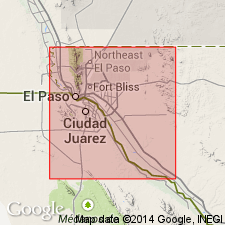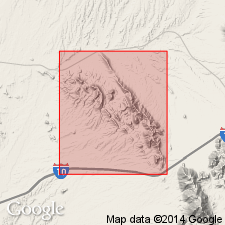
- Usage in publication:
-
- Malone bed
- Modifications:
-
- Original reference
- Dominant lithology:
-
- Gypsum
- Limestone
- Sand
- Breccia
- AAPG geologic province:
-
- Permian basin
Summary:
Pg. 720-721, 736. Malone bed. Described from exposures in Malone Mountains. In descending order: gypsum, 110 feet; massive blue granular limestone, 170 feet; white fissile granular gypsum, 45 feet; pale-yellow flaggy limestone, 25 feet. Underlies Etholen bed. Included in Washita division of Cretaceous. Three sections measured.
Source: US geologic names lexicon (USGS Bull. 896, p. 1273).

- Usage in publication:
-
- Malone beds
- Malone formation
- Modifications:
-
- Original reference
- Dominant lithology:
-
- Sandstone
- Limestone
- Gypsum
- AAPG geologic province:
-
- Permian basin
Summary:
Pg. 817-819. Malone beds or Malone formation. Fossiliferous sandstones and limestones, gypsums, massive calcite-seamed limestones, and any other rocks included among these of Malone Mountain[s] and hills north and east of Malone Station. The Malone formation thus assumes wider limits, a different age significance, and far greater importance than were assigned to it by Mr. Taff. Contains Jurassic fossils. [These fossils are now (ca. 1938) considered to be Upper Jurassic.]
Source: US geologic names lexicon (USGS Bull. 896, p. 1273).
For more information, please contact Nancy Stamm, Geologic Names Committee Secretary.
Asterisk (*) indicates published by U.S. Geological Survey authors.
"No current usage" (†) implies that a name has been abandoned or has fallen into disuse. Former usage and, if known, replacement name given in parentheses ( ).
Slash (/) indicates name conflicts with nomenclatural guidelines (CSN, 1933; ACSN, 1961, 1970; NACSN, 1983, 2005, 2021). May be explained within brackets ([ ]).

